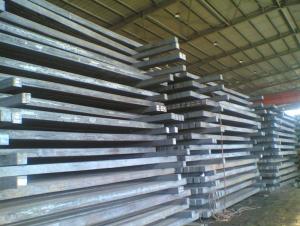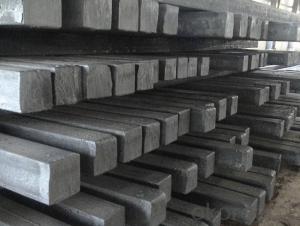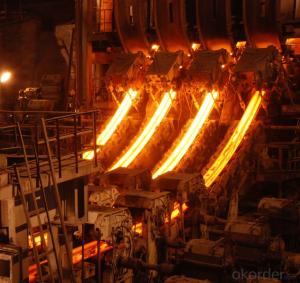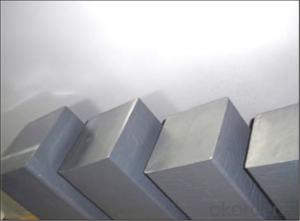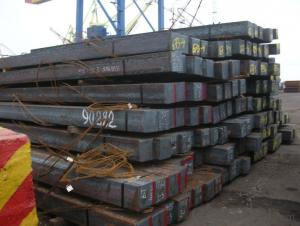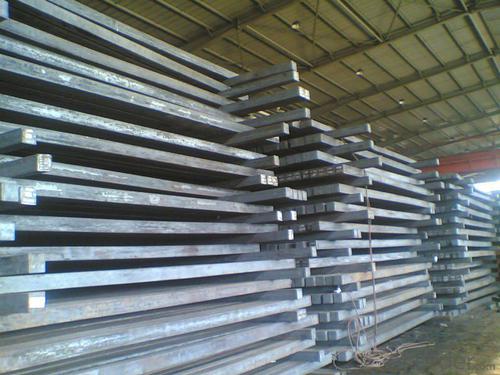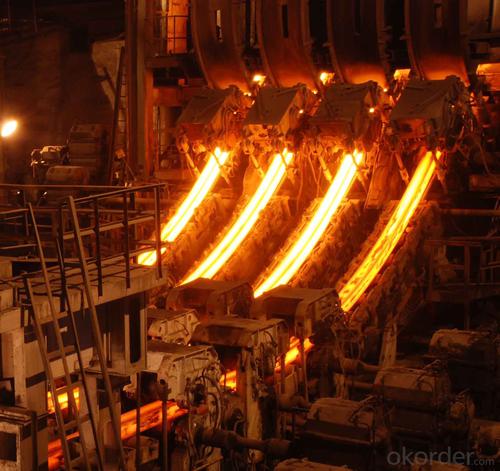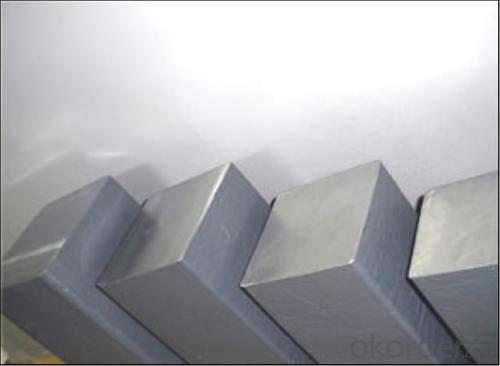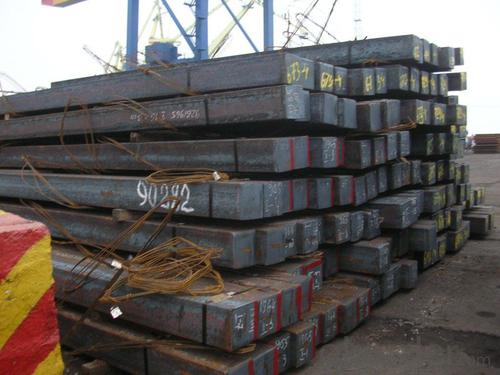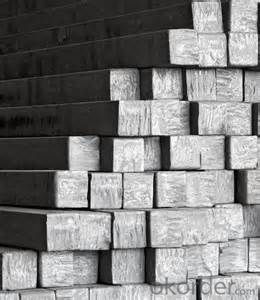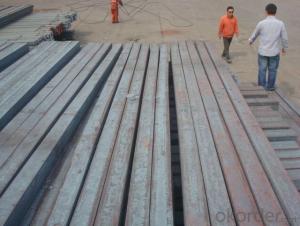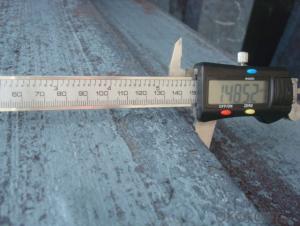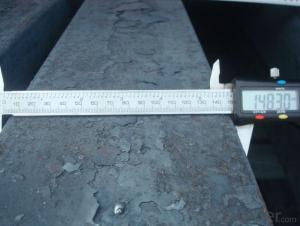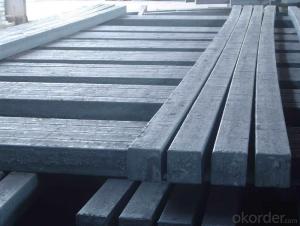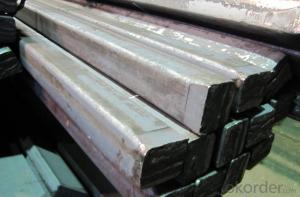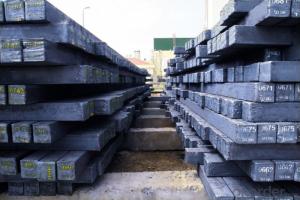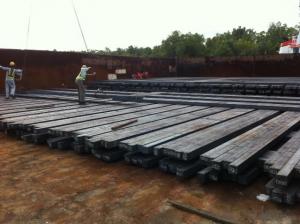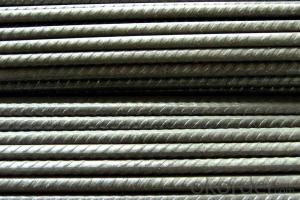Square Steel Billet Q235 3SP Grade Prime Quality 8#
- Loading Port:
- Tianjin
- Payment Terms:
- TT OR LC
- Min Order Qty:
- 2000 m.t
- Supply Capability:
- 50000 m.t/month
OKorder Service Pledge
OKorder Financial Service
You Might Also Like
Description of Square Steel Billet Q235 3SP Grade Prime Quality 8#
M. S. Billets are used for rolling of TMT Re-Bars of Fe415 and Fe500 Grade and various other structural steel products.
CRS Billets are used for rolling of CRS TMT Re-Bars.
Special Alloy Billets are used for rolling of any special grade TMT Re-Bars like Earthquake resistant TMT Re-Bars and for special grade structural steel products.
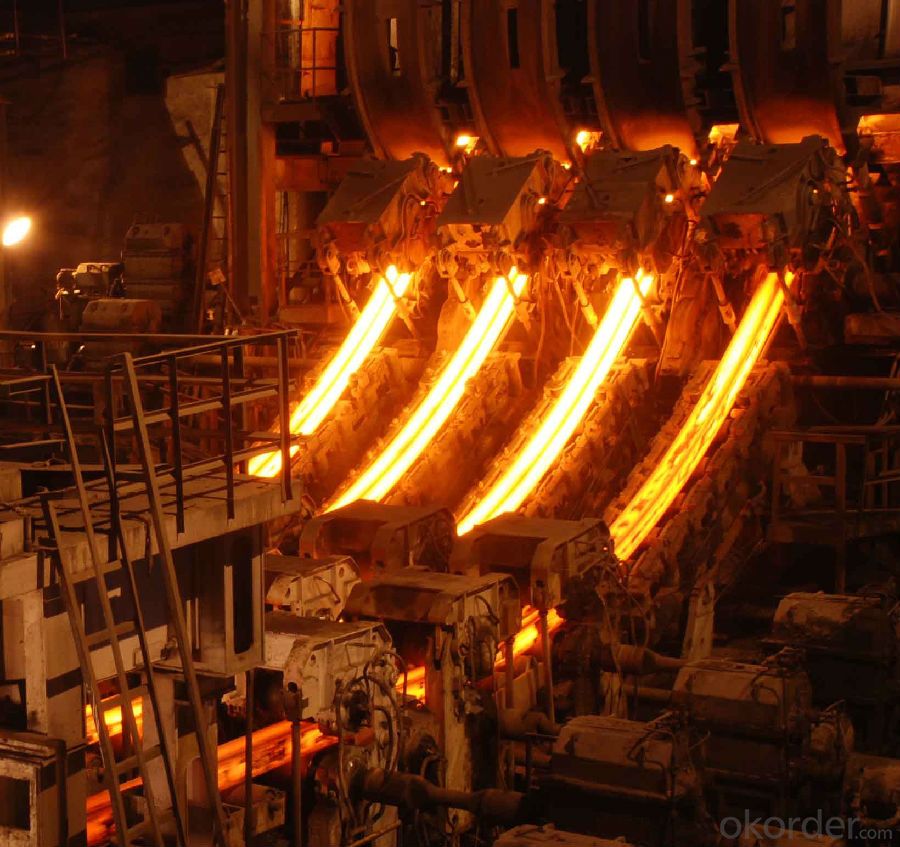
Main Feature Square Steel Billet Q235 3SP Grade Prime Quality 8#
Raw elements(C,Fe,Ni,Mn,Cr,Cu.)---Smelted ingots by AOD finery---hot rolled into black suface---pickling in acid liquid---cold drawn----polished by automatically machine--- cutting into pieces---checking quanlity
Applications of Square Steel Billet Q235 3SP Grade Prime Quality 8#
Widely Used in the areas such as Stainless Steel Fasteners, Chains, Kitchen and Sanitary wares, Furniture handles, Handrails, Electroplating and Electrolyzing pendants, Foods, Electron, Petroleum, Construction and Decoration, etc. Products have a high strength after cold-working. Electronic products parts, Medical appliance, Springs, Bus Inside and Outside packaging and building, Street Lamp Posts, etc. Decoration materials and Outdoor Publicity Billboard. Used for the products which have the Anti-Stress Corrosion requirement. Electron Products, Table-wares, Bolts, Nuts, Screen Meshes, Cumbustors and so on.
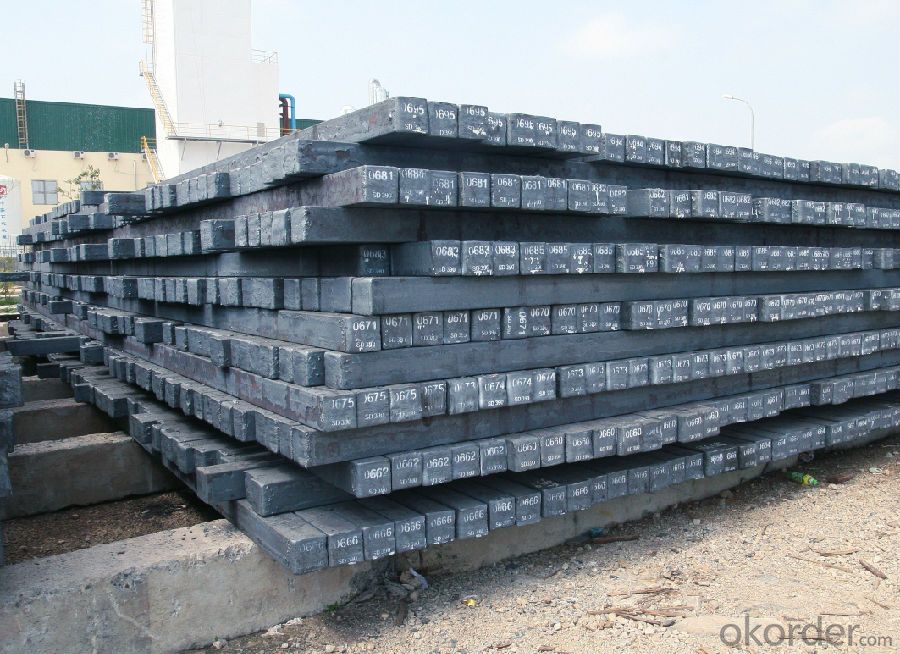
Specifications of Square Steel Billet Q235 3SP Grade Prime Quality 8#
| Standard | C(%) | Mn(%) | S(%) | P(%) | Si(%) |
| Q195 | ≤0.12 | ≤0.50 | ≤0.040 | ≤0.035 | ≤0.30 |
| Q235 | ≤0.20 | ≤1.40 | ≤0.045 | ≤0.045 | ≤0.35 |
| Q275 | ≤0.22 | ≤1.50 | ≤0.045 | ≤0.045 | ≤0.35 |
| 20MnSi | 0.17-0.25 | 1.2-1.6 | ≤ 0.050 | ≤ 0.050 | 0.40-0.80 |
| 3SP | 0.14-0.22 | 0.40-0.85 | ≤ 0.050 | ≤ 0.040 | 0.05-0.15 |
| 5SP | 0.28-0.37 | 0.50-1.00 | ≤ 0.050 | ≤ 0.040 | 0.15-0.30 |
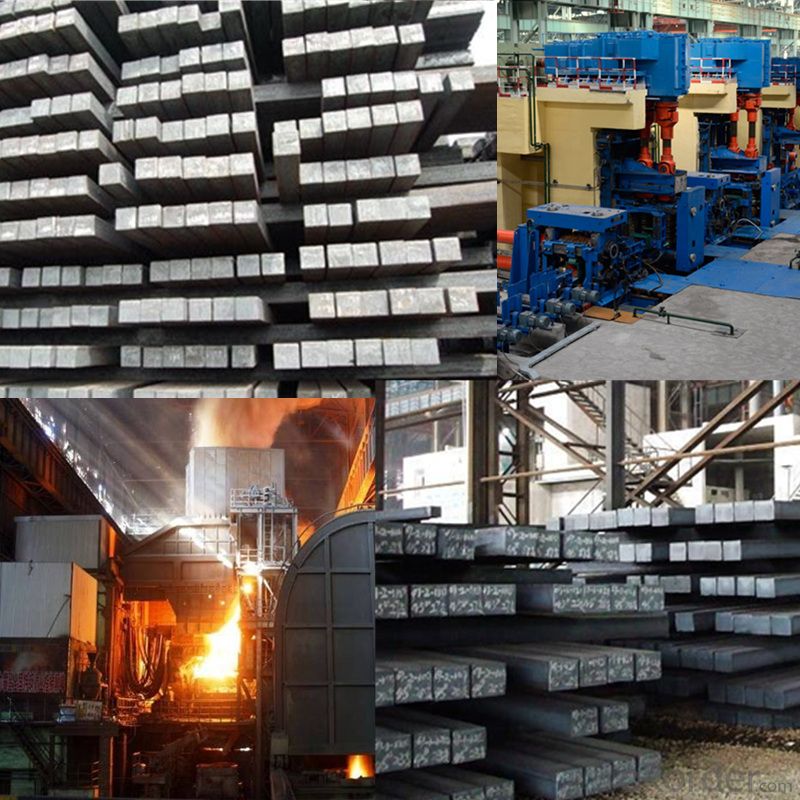
FAQ of Square Steel Billet Q235 3SP Grade Prime Quality 8#
We have organized several common questions for our clients,may help you sincerely:
1. How Can I Visit There?
Our company is located in Tianjin City, China, near Beijing. You can fly to Tianjin Airport Directly. All our clients, from home or aboard, are warmly welcome to visit us!
2. How Can I Get Some Sample?
We are honored to offer you sample.
3. Why choose CNBM?
Our delivery time about 15-20days for standard sizes, if you have other requirements like hardness, quanity and width ,it is about 20-40days. But don't worry we also try our best for the delivery time ,because time longer and our cost is higher.
- Q: What are the potential applications of steel billets in the textile aftermarket?
- Steel billets have limited potential applications in the textile aftermarket due to their heavy and rigid nature. However, they can be used as weights for fabric stretching or as support structures for heavy machinery in textile factories.
- Q: How do steel billets contribute to the food processing industry?
- Steel billets are used in the food processing industry to manufacture various equipment and machinery required for food production and processing. These billets serve as the raw material for constructing conveyor belts, mixers, crushers, and other machinery used in food processing plants. Additionally, steel billets are also utilized in the construction of storage tanks, processing vessels, and packaging equipment that maintain hygiene standards and ensure the safe and efficient handling of food products.
- Q: How are steel billets used in the manufacturing of bars and rods?
- Bars and rods are manufactured using steel billets, which are an essential part of the process. These billets have a cylindrical shape and act as the starting point for producing different types of bars and rods. To begin, steel billets are commonly created through continuous casting. This method involves pouring molten steel into a mold, which then solidifies and forms a billet. To enhance their workability and reduce the risk of cracking during subsequent processes, the billets are usually heated to a specific temperature. After the preparation of the billets, they are sent to rolling mills where they undergo intense pressure and high temperatures. This process, known as hot rolling, gradually shapes the billet into the desired form by passing it through a series of rollers. Depending on the specific requirements of the bar or rod being produced, the rolling mills can be equipped with different types of rolls, such as flat rolls or grooved rolls. During hot rolling, the billet is elongated and reduced in cross-sectional area, resulting in a longer and thinner product. This transformation enables the production of bars and rods with consistent dimensions and improved mechanical properties. Moreover, the hot rolling process refines the grain structure of the steel, thereby enhancing its strength and toughness. Following hot rolling, the bars or rods may undergo additional processes to achieve specific characteristics. These processes may include quenching and tempering, which optimize the mechanical properties of the final product, such as hardness and ductility. In conclusion, steel billets are crucial in the manufacturing of bars and rods. They are transformed through the hot rolling process to achieve the desired shape, dimensions, and mechanical properties. The versatility of steel billets allows for the production of a wide range of bars and rods used in various industries, including construction, automotive, and manufacturing.
- Q: What are the main challenges in the quality control of steel billets?
- The main challenges in the quality control of steel billets include several factors that can affect the final product's quality and performance. Here are some of the key challenges: 1. Chemical Composition: Ensuring the accurate chemical composition of steel billets is crucial as it determines the material's strength, durability, and other mechanical properties. Maintaining consistent chemical composition is challenging due to variations in raw materials, melting processes, and the presence of impurities. 2. Homogeneity: Achieving uniformity in the microstructure and composition throughout the steel billet is essential. Inadequate mixing or non-uniform cooling can lead to inconsistencies, resulting in weak spots and uneven mechanical properties. 3. Defect Detection: Identifying and eliminating defects in steel billets is essential to prevent failures during subsequent processing and usage. Common defects include cracks, inclusions, segregation, porosity, and surface irregularities. Detecting these defects accurately and in a timely manner can be challenging due to the size, complexity, and location of certain defects. 4. Dimensional Accuracy: Consistency in the dimensions and shape of steel billets is crucial for their further processing and use in various applications. Maintaining precise dimensions requires controlling variables such as casting speed, cooling rates, and mold design. 5. Surface Quality: The surface condition of steel billets is critical for subsequent operations like rolling, forging, or machining. Ensuring a smooth, clean, and defect-free surface is challenging due to factors such as scale formation, oxidation, decarburization, and surface contamination during handling and storage. 6. Heat Treatment: Proper heat treatment is often necessary to achieve the desired mechanical properties in steel billets. However, controlling the heating and cooling rates, as well as the soaking times, can be challenging due to variations in equipment, temperature monitoring, and quenching techniques. 7. Traceability: Maintaining traceability and documentation throughout the production process is crucial for quality control. Tracking the origin of raw materials, process parameters, testing records, and certifications can be challenging, especially in complex supply chains. Addressing these challenges in the quality control of steel billets requires a combination of advanced testing techniques, robust process controls, skilled personnel, and continuous improvement initiatives.
- Q: What is the process of heat treatment for steel billets?
- The process of heat treatment for steel billets involves heating the billets to a specific temperature, typically above the transformation temperature, followed by controlled cooling. This process helps to modify the microstructure of the steel, improving its mechanical properties such as strength and toughness. Different heat treatment techniques, such as annealing, quenching, and tempering, are used to achieve desired material properties for specific applications.
- Q: What are the main factors affecting the fatigue strength of stainless steel billets?
- The main factors affecting the fatigue strength of stainless steel billets include the composition and microstructure of the steel, the presence of surface defects or imperfections, the level of applied stress or load, the presence of corrosive environments, and the temperature at which the billets are operating.
- Q: What are the different types of surface defect detection methods for steel billets?
- There are various types of surface defect detection methods used for steel billets. Some of the commonly employed techniques include visual inspection, magnetic particle inspection, ultrasonic testing, eddy current testing, and laser scanning. 1. Visual Inspection: This is the simplest and most traditional method, where trained inspectors visually examine the surface of steel billets for any signs of defects such as cracks, scratches, or foreign material. 2. Magnetic Particle Inspection (MPI): MPI is a non-destructive testing method that uses magnetic fields and iron particles to detect surface defects. The billet is magnetized, and iron particles are applied to the surface. Any defect causes a leakage of magnetic flux, attracting the iron particles and forming visible indications. 3. Ultrasonic Testing (UT): UT involves the use of high-frequency sound waves to detect internal and surface defects in steel billets. A transducer emits ultrasonic waves into the billet, and the reflected waves are analyzed to identify any flaws or irregularities. 4. Eddy Current Testing (ECT): ECT utilizes electromagnetic induction to detect surface defects. A coil carrying an alternating current is placed near the billet's surface, which generates eddy currents. Any variation in the surface, like cracks or corrosion, alters the eddy currents, and this change is detected by the instrument. 5. Laser Scanning: Laser scanning is a relatively advanced method that uses laser technology to scan the surface of steel billets. The laser beam reflects off the surface, and a sensor analyzes the reflected light to identify any surface defects, such as scratches or dents. These different methods vary in terms of their sensitivity, speed, and cost-effectiveness. The choice of the appropriate surface defect detection method depends on factors such as the required level of accuracy, the type of defects to be detected, and the specific industry requirements.
- Q: How do steel billets contribute to the manufacturing of construction machinery?
- The manufacturing of construction machinery heavily relies on steel billets. These cylindrical or square bars of steel serve as the primary raw material for producing a wide range of components and parts used in construction machinery. Firstly, steel billets play a crucial role in creating the structural frame of construction machinery. The high strength and durability of steel make it an ideal material for guaranteeing the structural integrity of heavy machinery. By shaping and welding steel billets together, a sturdy frame is formed, providing the necessary support and stability to the equipment. Furthermore, steel billets are utilized in the manufacturing of critical components like gears, shafts, and axles. These components require high tensile strength and resistance to wear and tear, qualities that can be achieved using steel billets. By machining, forging, or casting steel billets into the desired shape, these components become capable of withstanding the heavy loads and harsh operating conditions present in the construction industry. Moreover, steel billets are essential in the production of buckets, blades, and cutting edges for construction machinery. These components face extreme forces and abrasion during excavation, grading, and other construction activities. The excellent hardness and toughness of steel billets ensure that these components can withstand such demanding conditions and perform effectively. Additionally, steel billets are necessary for the production of hydraulic cylinders and pistons. These components are responsible for generating the force needed to lift, push, and pull heavy loads in construction machinery. Through machining and shaping steel billets, cylinder bodies and pistons are created, guaranteeing the required strength and precision for efficient hydraulic operations. In conclusion, steel billets are indispensable in the manufacturing of construction machinery. They provide the necessary strength, durability, and wear resistance for the various components and parts used in construction equipment. By utilizing steel billets, construction machinery can withstand the demanding conditions and heavy workloads encountered in the construction industry, contributing to their overall performance and reliability.
- Q: What are the main differences between hot-rolled and cold-rolled steel billets?
- Hot-rolled and cold-rolled steel billets differ primarily in their manufacturing processes and resulting steel characteristics. To produce hot-rolled steel billets, the steel is heated above its recrystallization temperature, typically around 1200°C (2200°F), and then rolled into the desired shape or size. This involves the use of large-scale machinery, such as rolling mills, which apply significant pressure to shape the steel. Consequently, hot-rolled steel billets have a rough and scaled surface. On the contrary, cold-rolled steel billets are created by further processing the hot-rolled steel. The hot-rolled steel is cooled to room temperature and then passed through a series of rollers at lower temperatures, usually below 1000°C (1832°F). This process offers more precise control over the dimensions and surface finish of the steel. As a result, cold-rolled steel billets exhibit a smoother and more polished appearance compared to their hot-rolled counterparts. Regarding physical and mechanical properties, hot-rolled steel billets generally possess higher yield strength but lower ductility compared to cold-rolled steel. This is due to the hot-rolling process causing strain hardening in the steel, resulting in increased strength but reduced ability to deform without breaking. In contrast, cold-rolled steel retains more ductility as a result of the controlled rolling process at lower temperatures. Another significant distinction lies in the dimensional accuracy of the two steel billet types. Hot-rolled steel billets are known to have larger dimensional tolerances, meaning there can be variations in their thickness, width, and length. Conversely, cold-rolled steel billets possess tighter dimensional tolerances, leading to more precise and consistent dimensions. In summary, the primary differences between hot-rolled and cold-rolled steel billets stem from the manufacturing process, surface finish, physical and mechanical properties, and dimensional accuracy. Understanding these disparities is crucial when selecting the appropriate type of steel billets for specific applications, as each type offers its own advantages and disadvantages.
- Q: How many tons of billets does it take to produce a ton of thread steel?
- Domestic steel manufacturers, production rate of about 97%, so probably need 1/97%=1.03 tons.
Send your message to us
Square Steel Billet Q235 3SP Grade Prime Quality 8#
- Loading Port:
- Tianjin
- Payment Terms:
- TT OR LC
- Min Order Qty:
- 2000 m.t
- Supply Capability:
- 50000 m.t/month
OKorder Service Pledge
OKorder Financial Service
Similar products
Hot products
Hot Searches
Related keywords
